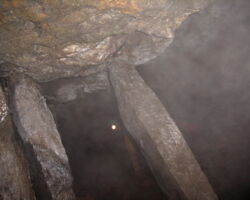To the west of Castleton by the side of the old 1810 road is Odin mine and crushing circle.
The steeply inclined gash to the west of the road marks the entrance to Odin mine. Traditionally its name is associated with having been worked as a penal settlement under the control of the invading Norsemen but no confirmation of this has been found.
It is known that written records confirm that it existed in 1260. Like many other lead mining ventures water was a constant problem and it was four hundred years later that these were overcome thus allowing lead production to increase until it peaked between 1720 and 1800. One hundred men, women and children worked the mine to produce up to eight hundred tones of lead ore per year.
The mine closed in 1847.
On the east side of the road lies the well preserved crushing circle dating from 1823.
The lead ore from Odin and other mines was brought here to be processed before being transported away to Bradwell to be smelted.
A horse drawn iron banded gritstone wheel mounted on a wooden beam circled the 18in diameter iron track to crush the ore. At other locations rollers were used to crush the ore but here can be seen the 70 inch diameter gritstone wheel and its 2inch thick iron band which was fixed to it by wedges in lateral grooves in the wheel rim.
from the Lead Legacy report –
Odin Mine, Knowlesgate and Engine Soughs, and Blue John Mine – Surface features to the east include a fine crushing circle/wheel with rare iron track and ‘tyre’, a gin circle with associated run-in/filled shafts, a disturbed belland yard wall and disturbed dressing floor/hillocks. Nearby there is the Knowlesgate Sough bolt with a line of sough shaft hillocks between it and the mine. West of the road is an impressive opencut into the hillside, with a small entrance to a side vein to the north side, with a diverted stream in a leat running above and to the side of the main opencut. The opencut gives access to large, extensive, underground stopes, a slab-roofed level and a drystone-arched/slab-roofed cart gate. Further west there are spaced shafts (run-in or capped) and associated hillocks that were sunk to workings under the shale. At one shaft mineral was brought to the surface but these large hillocks have now been largely removed and there is a 20th century tramway bed associated with this latter activity.
The other shaft hillocks include two or possibly three mounds along the early Engine Sough and a probable small shaft mound on another shale gate or trial. One shaft has a leat and this may have been used for a water blast. Odin Mine is documented as active in the second half of the 13th century. The Blue John Mine (currently a show cave) contains shafts sunk to natural caverns and historically important Blue John pipe deposits worked from the 18th century onwards.
Odin mine is listed as a Scheduled Monument.







